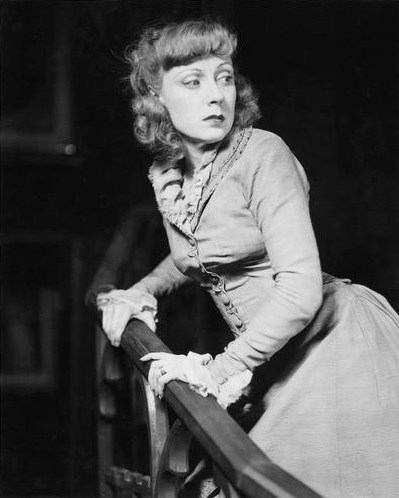Gas Light is a 1938 play written by Patrick Hamilton. The play and its film adaptations gave rise to the term “gaslighting”, a form of psychological abuse in which false information is presented to the victim with the intention of making them doubt their own memory and perception.
On the play’s transfer to Broadway in 1941 it was renamed Angel Street; film adaptations made in 1940 and 1944 used the title Gaslight.
Synopsis
The play is set in fog-bound London in 1880, at the upper-middle-class home of Jack Manningham and his wife Bella. It is late afternoon, a time Hamilton notes as being “before the feeble dawn of gaslight and tea.”
Bella is clearly on edge, and the stern reproaches of her overbearing husband (who flirts with the servants) make matters worse. What most perturbs Bella is Jack’s unexplained disappearances from their home, increasing her anxiety. It becomes clear that Jack is intent on convincing Bella that she is going insane, assuring her that it is only in her imagination that the gas light in their apartment is dimming.
The appearance of a police detective named Rough leads Bella to realise that Jack is responsible for her torment. Rough explains that the apartment above was once occupied by Alice Barlow, a wealthy woman murdered for her jewels, but the murderer never found them.
Jack goes to the apartment each night to search for the jewels, and lighting its gas lights causes those in the rest of the building to dim. His footsteps in the supposedly empty apartment above persuade Bella that she is “hearing things.” Rough convinces Bella to assist him in exposing Jack as the murderer, which she does, but not before she takes revenge on Jack by pretending to help him escape. At the last minute she reminds him that, having gone insane, she is not accountable for her actions. The play closes with Jack being led away by the police.
Productions
London
Gas Light premiered on 5 December 1938 at the Richmond Theatre in Richmond, London. It transferred to the Apollo Theatre on 1 January 1939, and to the Savoy Theatre on 22 May 1939. The cast featured Dennis Arundell (Mr. Manningham), Milton Rosmer (Mr. Rough), Gwen Ffrangcon-Davies (Mrs. Manningham), Beatrice Rowe (Elizabeth) and Elizabeth Inglis (Nancy). The production closed on 10 June 1939, after 141 performances.[1]
Broadway
Early in 1941, Vincent Price and his wife, actress Edith Barrett, saw Gas Light performed in Los Angeles as a three-hander titled Five Chelsea Lane. They were impressed with the play and set about securing the rights for a Broadway production of their own. Towards the end of the year they had found a producer to underwrite the project, but Barrett abruptly withdrew to remain in Hollywood and work in films, and in November 1941 Price returned to work on the New York stage. Judith Evelyn, the Canadian actress who had played the role of Mrs. Manningham in Los Angeles, was hired for the Broadway production. The name of the play was changed to Angel Street.[2]
Angel Street premiered on Broadway at the John Golden Theatre on 5 December 1941. Produced and directed by Shepard Traube, the cast featured Leo G. Carroll (Rough), Florence Edney (Elizabeth), Elizabeth Eustis (Nancy), Judith Evelyn (Mrs. Manningham) and Vincent Price (Mr. Manningham).[3][4] Price left the play after a year, when his working relationship with Evelyn deteriorated into what she described as his “violent dislike”.[2] In December 1942 the role of Mr. Manningham was assumed by John Emery. The play transferred to the Bijou Theatre on 2 October 1944, and closed on 30 December 1944 after 1295 performances.[3]
Revivals and adaptations
The play ran at New York City Center from 22 January 1948 to 1 February 1948, for 14 performances. Directed by Richard Barr, the cast featured José Ferrer (Mr. Manningham), Uta Hagen (Mrs. Manningham), Phyllis Hill (Nancy), Nan McFarland (Elizabeth), Ralph Roberts (Policeman), Victor Thorley (Policeman) and Richard Whorf (Rough).[5]
The play has since been revived several times, more recently at The Old Vic, London in June 2007, under the title of Gaslight. Directed by Peter Gill, the cast featured Andrew Woodall as Mr. Manningham, Rosamund Pike as Mrs. Manningham and Kenneth Cranham as Rough.[6]
Gas Light has also been adapted to film, in particular the British 1940 psychological thriller Gaslight directed by Thorold Dickinson, which is more true to the original plot than the more lavish 1944 MGM production of the same name.[7]
Critical reception
Louis Kronenberger wrote in his review of the 1948 City Center production that “it remains one of the better thrillers … let’s call it one of the best. All the same, though it holds up nicely for three acts, it seems to me outstandingly good for only one.” Brooks Atkinson, in The New York Times, is quoted as writing “As a creepshow, Patrick Hamilton’s Victorian melodrama remains close to the top of the class.”[8]


